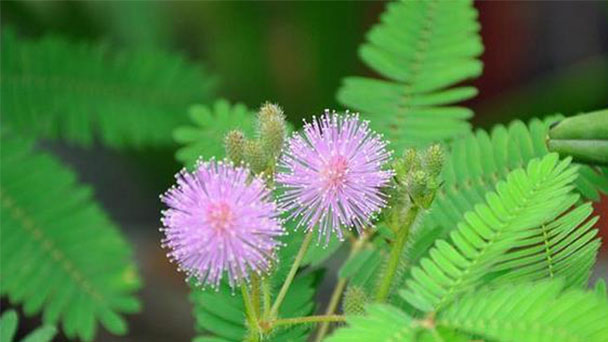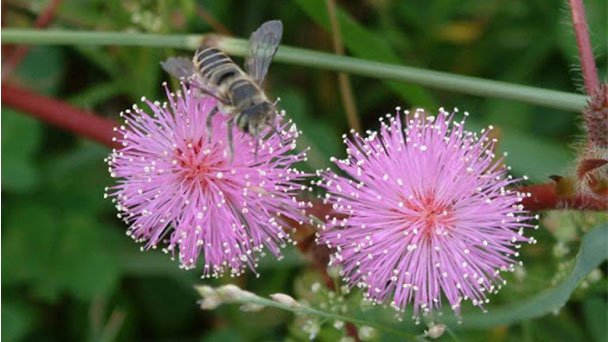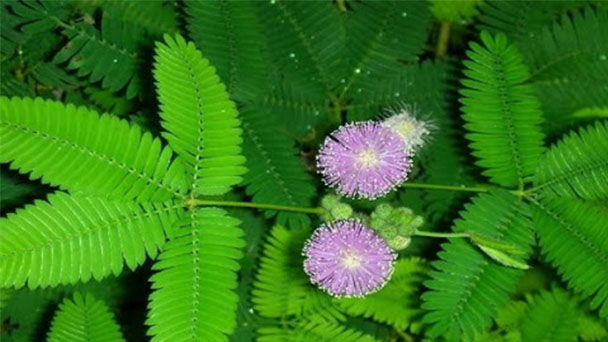Mimosa Profile
Written by Joy
Sep 27 2020

Mimosa is a leguminous perennial herb or subshrub. Because the leaves react to heat and light, they will immediately close when touched by external forces, so it is named Mimosa. Shaped like a pom-pom. Pods are formed after flowering, and the fruit is oblate. The leaves are feather-like compound leaves alternate, arranged in palm shape. It blooms after midsummer, with oblong flower heads and 2-3 in the leaf axils. The flower is white and pink, the calyx is bell-shaped, with 8 tiny calyx teeth, the petals are four-lobed, the stamens are four, and the ovary is glabrous. The pods are flat, with 1 seed per pod node, which falls off between nodes when mature. Flowering in September.


Planting method. General sowing and breeding, sowing from late March to early April. Sprinkle the seeds evenly on the fine soil, cover about 1.5 cm of soil, at a temperature of about 18 ℃, the seedlings can emerge in about 10 days (generally, it grows when you enter the soil, no special management is required). The seedling stage grows slowly, and it can be planted at 7 to 8 cm.


Mimosa morphological characteristicsMimosa growth habitMimosa growing environment and distributionMimosa efficacy and roleMimosa cultivation
Mimosa morphological characteristics
Shaped like a pom-pom. Pods are formed after flowering, and the fruit is oblate. The leaves are feather-like compound leaves alternate, arranged in palm shape. It blooms after midsummer, with oblong flower heads and 2-3 in the leaf axils. The flower is white and pink, the calyx is bell-shaped, with 8 tiny calyx teeth, the petals are four-lobed, the stamens are four, and the ovary is glabrous. The pods are flat, with 1 seed per pod node, which falls off between nodes when mature.Mimosa growth habit
Mimosa is a moist-loving and well-drained flower plant that lives in the tropics. Therefore, you'd better keep the potting soil moist and not too dry; it is hot in the summer, so pay attention to the actual situation and water it, about once a day . That is, spray more water on the leaves, water less in winter, and water only when the surface soil becomes dry. Mimosa must be kept insufficient light, so it is best to place it on a sunny window or balcony. Adequate sunlight is conducive to the growth of mimosa. Insufficient light will cause the plant to stop growing or turn yellow and wither. Mimosa is a tropical plant. It is most suitable to keep the growth temperature between 20 and 28 degrees. If the temperature is too low, the mimosa will stop growing. When the temperature is lower than 10 degrees, certain protection measures are required.Mimosa growing environment and distribution
Native to tropical America, it has been widely distributed in tropical regions of the world. Produced in China, Taiwan, Fujian, Guangdong, Guangxi, Yunnan, and other places. Born in the wilderness, in the bushes, the Yangtze River valley is often cultivated for viewing. Mimosa prefers a warm, humid, sunny environment, and is suitable for well-drained sandy loam soil rich in organic matter. The plant is robust, grows fast, and has strong adaptability.Mimosa efficacy and role
It has the effects of clearing heat and diuresis, resolving phlegm and relieving cough, soothing the nerves and relieving pain, detoxification, removing blood stasis, stopping bleeding, and astringent. Used for colds, high fever in children, acute conjunctivitis, bronchitis, gastritis, enteritis, urinary calculi, malaria, neurasthenia; external use to treat bruises, swelling, and pain, sore swelling, hemoptysis, herpes zoster.Mimosa cultivation
It can be cultivated in general soil. It does not require much fertilizer during the growth period. You can apply to dilute liquid fertilizer 2 to 3 times. Do not use too much fertilizer. Use leaf green to grow robustly. Do not grow too much, because mimosa is mainly an interesting foliage flower, Small size is better. The planting technique of mimosa is simple and the management is extensive. The requirements for climate, sunlight, and soil are not strict, but fertile, loose sandy loam is better, and it likes a warm and humid environment.Planting method. General sowing and breeding, sowing from late March to early April. Sprinkle the seeds evenly on the fine soil, cover about 1.5 cm of soil, at a temperature of about 18 ℃, the seedlings can emerge in about 10 days (generally, it grows when you enter the soil, no special management is required). The seedling stage grows slowly, and it can be planted at 7 to 8 cm.
Latest Updated
- Benefits of Bugleweed - 7 Science-backed Health Benefits
- Bugleweed Dangers & Side Effects - Is It Poisonous?
- How to Plant Evergreen Trees - What You Should Know
- When to Plant Evergreens - Grow Guide for Evergreen Trees
- 12 Wonderful Evergreen Shrubs for Your Garden
- 12 Popular Evergreen Plants with Pictures for Beginners
- When And How To Prune A Lilac Bush Like a Pro
- How to Grow & Care for Lilac Vine (Hardenbergia Violacea)
- Japanese Lilac Tree (Syringa Reticulata) Care & Propagation Guide
- Shumard Oak Pros and Cons - What to Know
Popular Articles
- Winter maintenance of Antirrhinum Majus
- How to Grow Terminalia Mantaly Tree
- How to Grow and Care for Crossostephium Chinense
- How to grow Antirrhinum Majus in spring
- Peristeria Elata (Dove Orchid) Profile: Info & Care Guide
- Underwatered Snake Plant (Sansevieria Trifasciata) - Signs And How To Fix
- How to Care for Brazilian Jasmine Plant (Mandevilla Sanderi)
- How to Grow & Care for Graptopetalum Purple Delight in Summer
- Rosa Chinensis (China Rose): Plant Growing & Care Tips
- How to Care for Baby Sun Rose (Aptenia Cordifolia)